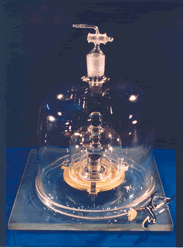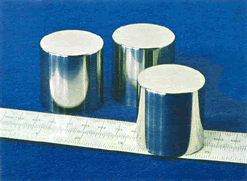Making the first international kilograms and metres
Much of the emotive opposition to the use of metric in Britain is along the lines that it is a “foreign imposition”. Imperial units on the other hand are claimed to be “home grown”. Of course reality is very different, with the pound and mile being imposed by Roman invaders and the acre and furlong by Anglo-Saxon ones. Since Victorian times (and without the French having to invade Britain!) there have been many occasions when the advantages of metric have been recognised in the UK such as the Select Committee on Weights and Measures of 1862. Britain’s significant contribution to the international system of units generally and particularly its role in making the international kilogram and metre prototypes is virtually unknown in the UK.
Of course, there is no doubt that the metric system originates in France. Despite the chaos of revolutionary France, many eminent scientists there recognised the need for a unified set of measures. Measures varied from province to province and this confused trade. The National Assembly formed a Commission in 1789 to come up with a unified system. Eminent French scientists were involved including the “father of chemistry” Lavoisier and they came up with some familiar units including the metre and the kilogram. Standard prototype measures were developed including a platinum cylindrical kilogram made by Marc Etienne Janety.
With the metric system taking an international dimension, the French government wisely sought to make metric an international rather than a national initiative. This resulted in the signing of the Convention du Mètre (Metre Convention) in May 1875; a diplomatic treaty between an initial set of 17 countries. Britain signed the Convention in 1884 and there are now 57 member countries, including all the major industrialised countries.
A challenge of the newly formed International Bureau of Weights and Measures (Bureau international des Poids et Mesures, BIPM) in Paris was to construct international prototypes for the metre and kilogram and to distribute national copies for members of the Metre Convention. For the kilogram, it was agreed that the new prototype should be made from an iridium-platinum alloy. The 10% iridium/90% platinum alloy was chosen because of its high density, corrosion resistance and stability.
Initial attempts to manufacture the alloy had failed so in 1882 the London firm Johnson, Matthey & Co, which had previously manufactured standard measures for Russia, was brought in. The contract included 30 standard metres and 40 standard kilograms in iridium-platinum alloy. The standard kilograms, delivered in 1884, were 39 mm in diameter and 39 mm in height. The kilograms cast in London by George Matthey were then hammered, polished and adjusted to match the previous standard by M Collot in France . The international kilogram was cast in the UK and finished in France; a truly international effort typical of further development of the international system of units.
Matthey & Collot’s prototype remained the definition of the kilogram until 20 May 2019, when it was finally superseded by a definition based on constants of nature. It is stored in three nested bell jars at BIPM.

The first General Conference on Weights and Measures approved the kilogram and metre prototypes in 1889 and the signatories to the metre convention were given copies. Britain had joined the Metre Convention in 1884 and so received copy number 18. This “official British kilogram” is stored at the National Physical Laboratory in Teddington.

Since the 1880s BIPM has commissioned more than eighty platinum/iridium prototype kilograms including those manufactured by Johnson Matthey below.

The international prototype of the kilogram served international metrology for over a century. However, in 2019, it was finally superseded by a more precise and stable definition in terms of the Planck constant. Similarly, the standard iridium-platinum metre prototype had earlier been superseded by a more precise definition in terms of the distance travelled at the speed of light during a specific fraction of a second.
The international prototype kilogram and prototype metre (both now retired) are part of British metrology and metallurgy heritage.
